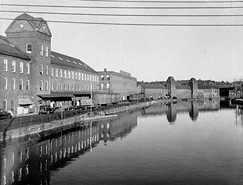industrialization & immigration
French-Canadian Immigrants in Holyoke
Many French-Canadians were initially recruited to work in the textile mills, and so settled in the neighborhood around the Lyman Mills complex, which stretched an eighth of a mile west from Hadley Falls. By the turn of the century, Lyman Mills employed 1200 people, the majority of which were women and children, and most of those of French-Canadian descent. By providing small, periodic raises (and relying upon non-unionized women and children), the Lyman Mills operators avoided the strikes that disrupted other textile manufacturers in Lawrence and Fall River, Massachusetts. With women and children employed in the textile mills, French-Canadian men found work as day-laborers and semi-skilled craftsmen, then transitioned to carpentry, construction, and jobs in the paper mills in later years.
The growing influx of French-Canadians led the Diocese of Springfield to establish the parish of the Precious Blood in 1869 to serve French-speaking Catholics in Holyoke. A new neighborhood of French-Canadians grew up around the church building on Park Street, west of the mills. French-speaking Protestants organized a Congregational Church in 1884, which met in various buildings before settling in the chapel of the Second Congregational Church downtown. A second Catholic parish, Our Lady of Perpetual Help, was formed in 1890 to serve the growing French-Canadian population in the northern section of the city. The new building on the corner of Maple and Prospect streets served as a church, school and convent.
Because of the proximity of their home country, many French-Canadians immigrants did not feel an urgent necessity to assimilate to U.S. society and culture. They were often stereotyped as "birds of passage," traveling back and forth to Canada and maintaining strong cultural links to their Quebecois roots. Many regarded Holyoke as a temporary home, and in 1885 only about a fifth of the French-Canadian population of the city were U.S. citizens. Life in the mills, the creation of new neighborhoods and the growth of church communities eventually led to a more stable population, however, and French-Canadians began to adapt to life in the U.S.
Towards the end of the nineteenth century, French-Canadians founded a number of secular social groups and mutual benefit societies, and built two social halls alongside church properties. The churches also began to encourage naturalization, and the popular Catholic schools began allowing classes taught in English. New national laws limiting child labor and truancy increased the number of French-Canadian children attending public schools. French-Canadian workers, facing increasing competition from an influx of Polish and Italian immigrants, began to join unions in larger numbers. A fear of Prohibition (driven by anti-Catholic, anti-immigrant sentiment) motivated many French-Canadians to vote; twice they provided the margin to overturn local liquor bans. Participation in unions and civic groups, the teaching of English and the increase in suffrage among French-Canadians signaled a new openness to Americanization and the creation of a new immigrant community in the Connecticut River Valley.
